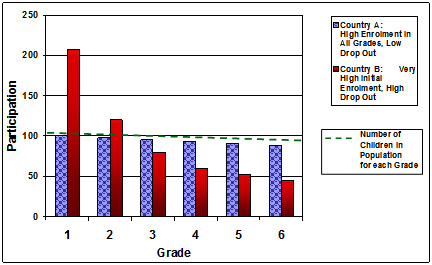Indicators
Some indicators of access to education are not fit for purpose. Average Gross and Net Enrolment Rates (GERs and NERs are poor indicators insensitive to changes in the composition of enrolments by age. GERs and NERs can increase or decrease when participation is improving and thus provide ambiguous signals to policy makers. The figure shows how countries with different enrolment patterns by grade can have the same GERs and NERs. Country A has excess enrolment in Grade 1 with high attrition. Country B has more even enrolment across grades. They have the same GER. With minor assumptions about the composition of age in grade they could have the same NERs. Grade specific enrolment rates and completion rates are more useful than cycle length GERs and NERs (Lewin 2011c).
Similar GERs in Two Countries with Different Enrolment Patterns

CREATE case study data and secondary analysis reveals vast differences in the conditions under which children learn. The poorest often have no access to clean water and sanitation, no learning materials, and poorly qualified teachers with large classes. The expanded vision of access depends on reducing the gap in the learning environment between the most and least favoured locations. Universal access and completion cannot be achieved without much more equitable distribution of opportunities to learn. Goals, targets and indicators have to include measures that capture who gets what and in terms of educational access how this is changing.